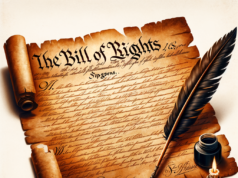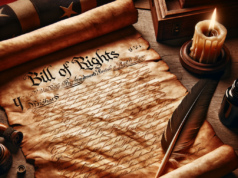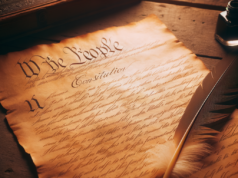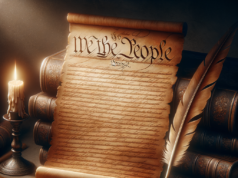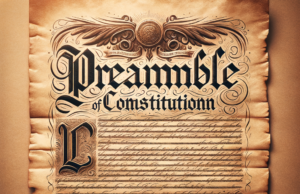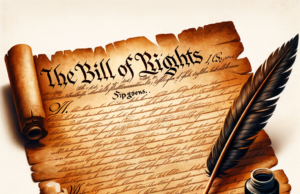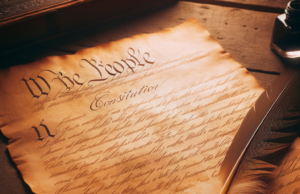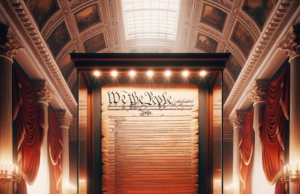Table of Contents
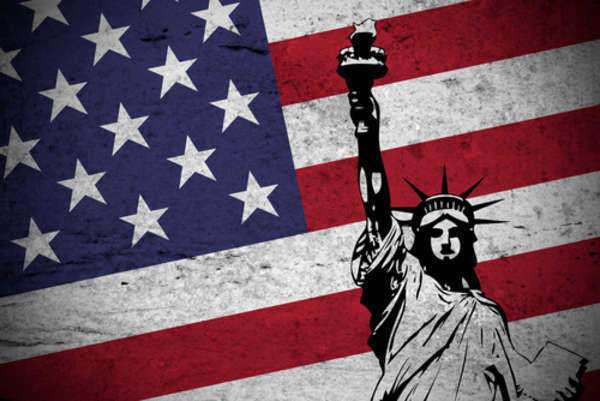
States’ Rights in the United States: A Comprehensive History and Analysis
Since the founding of the United States, the issue of states’ rights has been a constant source of debate. At its core, the issue is whether individual states have the right to govern themselves or whether the federal government has the power to override state laws and regulations. This debate has played out in many ways over the years, from the fight over slavery and the Civil War to the current battles over issues like healthcare and immigration.
The concept of states’ rights is closely linked to the idea of federalism, which is the idea that power should be distributed between the federal government and the states. In the United States, this principle is enshrined in the Constitution, which outlines the powers of the federal government and reserves all other powers to the states or the people.
In this article, we will take a closer look at the history of states’ rights in the United States, examining how this issue has impacted the country and the ways in which different political groups have sought to assert their views on the topic.
Origins of the States’ Rights Debate
The debate over states’ rights began before the United States was even formed, as the colonies that would later become the states began to resist British attempts to exert greater control over them. After the American Revolution, this resistance continued as the new United States struggled to find a balance between the power of the federal government and the rights of individual states.
The issue of states’ rights came to a head in the early 19th century when the United States was expanding westward and new states were being admitted to the Union. Many of these new states were dealing with issues related to slavery, and the federal government was struggling to find a way to address this issue without infringing on states’ rights.
The Missouri Compromise of 1820 attempted to resolve this issue by allowing Missouri to enter the Union as a slave state while allowing Maine to enter as a free state, and by drawing a line across the country along which slavery would be allowed in some states but not in others. However, this compromise did not fully resolve the issue of states’ rights, and tensions continued to escalate over the coming decades.
The Civil War and the Issue of States’ Rights
The issue of states’ rights was a major factor in the outbreak of the Civil War, which began in 1861. The Confederate states, which seceded from the Union, cited states’ rights as a major reason for their decision to secede and form their own country.
At the heart of the conflict was the issue of slavery. The southern states believed that they had the right to govern themselves and to decide whether or not to allow slavery within their borders. The federal government, led by President Abraham Lincoln, believed that the Union had the power to override state laws and regulations in order to abolish slavery and preserve the country.
The Civil War was a devastating conflict that claimed the lives of hundreds of thousands of Americans and left the country deeply divided. In the aftermath of the war, Reconstruction efforts aimed to restore the power of the federal government and to ensure that the rights of African Americans were protected. However, many white southerners continued to resist these efforts, leading to further conflict and tension in the years to come.
States’ Rights in the 20th Century
In the early 20th century, the issue of states’ rights began to take on new dimensions as the country faced a range of new challenges. One of the most significant of these challenges was the Great Depression, which led to widespread economic hardship and raised questions about the role of the federal government in addressing these issues.
President Franklin D. Roosevelt implemented a range of programs and policies aimed at addressing the economic crisis, but many of these efforts were met with resistance from conservative politicians who believed that the federal government was overstepping its bounds and infringing on states’ rights.
In the years that followed, the issue of states’ rights continued to be a source of contention as the country dealt with a range of issues related to civil rights, the environment, and other major policy areas. At times, the federal government was able to assert its authority and implement new policies in these areas, while at other times, states were able to push back and maintain their own laws and regulations.
Recent Developments in States’ Rights
In recent years, the issue of states’ rights has taken on new importance in a number of areas. One of the most significant of these areas is healthcare, where the federal government has sought to implement new regulations and policies aimed at reforming the healthcare system.
Under the Affordable Care Act, also known as Obamacare, the federal government sought to implement a range of new regulations and policies aimed at expanding access to healthcare and reducing costs. However, many conservative politicians and states have pushed back against these efforts, arguing that they represent an infringement on states’ rights.
Another major issue related to states’ rights is immigration, where the federal government has sought to implement new policies aimed at controlling the flow of people into the country. However, many states and localities have resisted these efforts, implementing their own policies and regulations aimed at protecting immigrants and ensuring that they are treated fairly.
Other recent developments related to states’ rights include the legalization of marijuana in some states, which has led to conflicts with federal drug laws, and the expansion of voting rights, where some states have implemented new laws and regulations aimed at restricting access to the ballot box.
Conclusion
The issue of states’ rights has been a constant source of debate and conflict in the United States, from the colonial era to the present day. While the country has made significant progress in addressing a range of issues related to civil rights, healthcare, and other major policy areas, the issue of states’ rights remains a contentious and important one.
As the country continues to grapple with new challenges and opportunities, it is likely that the issue of states’ rights will continue to be a source of debate and tension. However, by working together at the federal, state, and local levels, Americans can continue to address these issues and build a stronger, more resilient country for the future.
States’ rights are grounded in the United States Constitution under the 10th Amendment to the United States Constitution. The 10th Amendment states that “the powers not delegated to the United States by the Constitution, nor prohibited by it to the States, are reserved to the States respectively, or to the people.”
The interpretation of the 10th Amendment has been argued over the entire history of the United States. Where some interpret the Constitution to have a strict construction, meaning that the federal government is permitted pass laws in strict compliance within the specific language of the constitution others have interpreted the Constitution to allow the federal government to regulate and make laws that are “necessary and proper” to achieving the goals set forth in the “enumerated powers” of Article 1, section 8 of the United States Constitution.
The enumerated powers are a list of duties that Congress is entrusted with. These consist of 18 clauses outlining the duties of Congress. These include the authority to raise an army, to borrow money, lay taxes, coin money, create a post office, declare war, and create inferior federal courts, among others. Those individuals who stand for strict construction of the constitution believe that the authority given to Congress through these 18 clauses are black and white and that the federal government does not have the authority to expand Congress’s influence. Those who follow the expansionist view specifically focus on clause 18 of section 8 and the “necessary and proper” clause.
The necessary and proper clause, as stated in Article 1, section 8, clause 18 states that “the congress shall have Power – To make all Laws which shall be necessary and proper for carrying into Execution the foregoing Powers, and all other Powers vested by this Constitution in the Government of the United States, or in any Department or Officer thereof.”
What this means is that the federal government may create laws and regulations that are “necessary and proper” to achieve the goals of the federal government concerning the enumerated powers. A great example of the “necessary and proper” clause at work is by looking at the commerce clause of Article 1, section 8, clause 3 of the United States Constitution.
The commerce clause; under Article 1, section 8, clause 3 states that Congress has the authority “To regulate Commerce with foreign Nations, and among the several States, and with the Indian Tribes.” A state rights, strict constructionist, the view would look at this as being black and white, having the interpretation follow logically that Congress may regulate interstate travel on and goods that have been put in the stream of commerce. A more expansive viewpoint would be that of the holding of Wickard v. Filburn where the Supreme Court found that the effects of a farmer growing too much wheat on his property, in the aggregate, would affect interstate commerce and, thus, Congress had the right to regulate it.
This argument over the rights designated to Congress through Article 1, section 8 of the United States Constitution, and the 10th Amendment are the main points of argument held by those who follow state rights; and a strict constructionist view, and those who follow an expansionist view of the Constitution.
States Rights in United States History up to the Civil War
The argument of state rights began even before the drafting of the Constitution. Prior to the Constitution, the United States government was bound by the Articles of Confederation. The Articles of Confederation created in its strong respect for states’ rights and left a very weak federal government. Subsequently, during the drafting of the Constitution, one of the aims was to strengthen the federal government. Many proponents felt that states’ rights should be afforded greater weight and in that regard, the 10th Amendment was drafted to appease those individuals concerned with centralized power.
One of the first instances where the idea of state’s rights in the Constitution came to the forefront was during the Washington administration and the dispute over the creation of a national bank. Alexander Hamilton, then the secretary of the treasury, intended to use the enumerated powers, along with the necessary and proper clause, to create a national bank of the United States. Advocates of States rights such as Thomas Jefferson and James Madison argued that this was not within the strict construction of the Constitution.
Washington sided with Hamilton and upon the creation of the national bank essentially split the founders into two different sects and, in essence, was a large contributing factor to the creation of the first major parties in American politics; the Federalists, controlled by Washington and Adams, and the Republicans; dominated by Jefferson and Madison. The Federalists would argue on the platform of implied powers whereas the Republicans were advocates for “strict construction” and states’ rights.
The argument over implied powers and states’ rights came to a head once again during the Adams administration when the Federalist controlled Congress adopted the Alien and Sedition laws which prohibited actions, even verbal comments, against the government. The Republicans argued that this was a direct violation of the 1st Amendment to the Constitution and Jefferson and Madison countered the acts by independently drafting the Kentucky and Virginia resolutions which were meant to assert state rights and send a message to the federal government that the States had a right to nullify laws proposed by the federal government to be too far-reaching. Essentially the resolutions claimed that the federal government served at the will of the states and that states’ rights were paramount to those proposed by the federal government.
The issue of States rights versus implied powers was resurrected once more during the Jefferson administration and the Louisiana purchase. Strict constructionists who advocated for states’ rights and the limitations on the powers of the federal government opposed the purchase, stating that it was not within the powers granted to the federal government to expand the nation beyond its current borders. Ironically, these arguments were brought against Jefferson, one of the original proponents for states rights and strict construction.
The implied powers of Congress were once again tested during the nullification acts of 1832. This issue came about due to tariffs that were imposed on goods that were being imported into the United States. In the current economic climate, the southern states relied on goods from Europe and from the northern states in order to meet their economic needs. Because of stiff competition with Europe, Congress, at the behest of the northern states imposed tariffs upon European goods shipped into the country.
The result was that the southern states were either reduced to dealing only with the northern states for necessary goods or paying higher prices for European goods. In response, South Carolina, under the policies of John C. Calhoun, proposed a reformulation of the Virginia & Kentucky Resolutions. The new resolution essentially stated that the people in each state were sovereign and only by their will was there any power given to the state of federal governments. As a result, South Carolina refused to obey the tariff acts of 1828 or 1832 and in response, President Jackson asked Congress for the right to send in the navy and army for enforcement of the law.
The issue involving states’ rights versus implied powers really came to a head in the issue of slavery. Advocates of the implied powers claimed that the issue of slavery was one for the federal government to decide, as was done through the Compromise of 1820 and 1850. Advocates for state rights claimed that it was for each individual state to decide whether it should permit slavery within its borders and argued that the federal government was permitted to adopt rules and regulations but could not designate the policies that affected the states. States rights advocates won a battle on this issue with the holding in the Dredd Scott decision whereby Justice Taney declared that “The Government of the United States had no right to interfere for any other purpose but that of protecting the rights of the slave owner.”
The 14th Amendment
With the end of the civil war came Amendments to the Constitution banning slavery and calling for the equal treatment of African-Americans throughout the United States. In addition, the 14th Amendment attempted to lay to rest any idea of states rights usurping the Constitutional guarantees prescribed by the federal government. In this, the 14th Amendment contains, what is known as, the equal protection clause.
The equal protection clause is stated in section 1 of the Amendment and notes that “No State shall make or enforce any law which shall abridge the privileges or immunities of citizens of the United States; nor shall any State deprive any person of life, liberty, or property, without due process of law; nor deny to any person within its jurisdiction the equal protection of the laws. This clause solidified the Constitution, and the Amendments to the Constitution, as being, not only a federal right but subjected the Amendments to the States as well.
States Rights and The Civil Rights Era
Probably the largest issue of states rights post-civil war came about during the civil rights movement. In response to Jim Crow, the federal government began a series of reforms, beginning with the Supreme Court decision in Brown v. The Board of Education, which officially overturned the decision in Plessy v. Ferguson and declared that “separate but equal”, was not constitutional.
In response, many proponents against integration declared that the federal government did not have the authority to require integration by the states as it would be a violation of state rights. States refused to integrate and it was not until a show of force by the federal government that the states began to recede from their previous stance.
States Rights and the Commerce Clause
One of the most contentious issues involving states rights is the issue involving the commerce clause. The federal government has been able to use the commerce clause in a number of situations to expand the authority of the federal government into areas where, without the necessary and proper clause, would be deemed to be an unconstitutional intrusion upon states’ rights. The federal government has been able to use the commerce clause to enter almost any situation where something is put into the stream of commerce. As discussed above, the case of Wickard v. Filburn took this to extreme lengths arguing the “aggregate” view.
Many issues have come to the forefront lately involving the death penalty, assisted suicide, gay marriage, gun rights, and the health care individual mandate.
Currently, the health care individual mandate that is one of the cornerstones of the Obama administration’s health care bill is working its way up to the Supreme Court of the United States. Currently, the appellate courts have been split as to the constitutionality of the issue. States rights advocates for strict construction advocate that the Constitution’s enumerated powers, even with the expansive view of the commerce clause through the “necessary and proper” clause do not afford the federal government to mandate that an individual be required to pay for health care.
In the alternative, those who are against the state’s rights assertions argue that the commerce clause, along with the necessary and proper clause permits the federal government to mandate that each individual in this country pay for their own health care or face a penalty. It is yet to be determined where the high court will rule on this argument but it is a strong possibility that states rights advocates will be disappointed.






